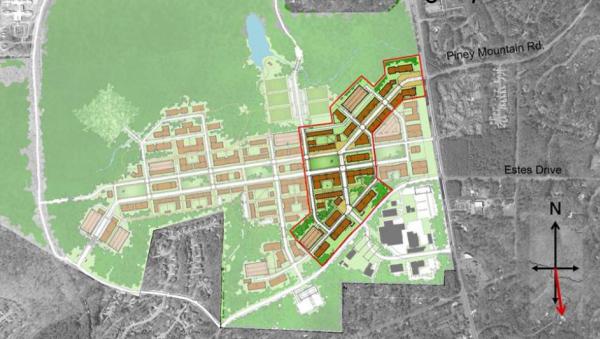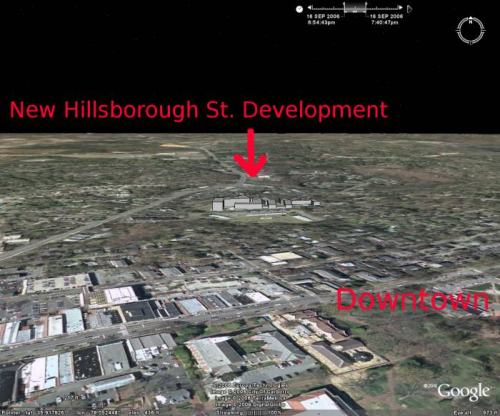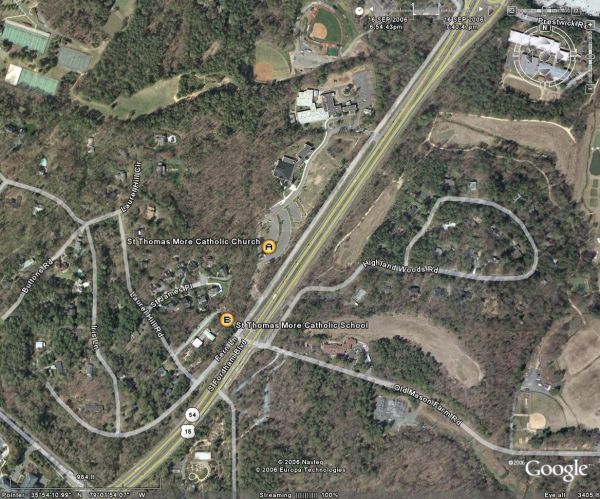Though not averse to appropriate rail deployments, I’d like to see our community support the cheaper, more flexible Bus Rapid Transit (BRT) approach before plunging back into a rail-centric system.
Regional transit policy needs an “evergreen” process to address our community’s rapidly changing needs.
The commission membership has some real local talent, including former Council member Gerry Cohen (of the excellent NC Bill Drafting ‘blog) and Chapel Hill Planning Board member George Cianciolo (GeorgeC on OP).
Here is the membership list of the new 4 county transit planning committee, CAMPO are the Wake/Johnston appointments, DCHC-MPO are the Durham/Orange appointments. Bio sketches are from the staff memoranda.
CAMPO:
Bill Cavanaugh, (Co-Chair)
Former chairman, chief executive officer, and president, Progress Energy Chairman of the World Association of Nuclear Operators (WANO) Member of the National Academy of Engineering Board of visitors at the University Of North Carolina Kenan Flagler School Of Business Advisory Board of Tulane’s School of Engineering Board of Directors for Research Triangle Foundation
Smedes York, (Co-Vice Chair)
Mayor, City of Raleigh, 1979-1983 Raleigh City Councilman, District E, 1977 to 1979. President of York Properties, Inc. Board Chairman York Simpson Underwood and McDonald-York Past chairman of the North Carolina Citizens for Business and Industry Past chairman N.C. State University Board of Trustees Board of Directors of the Research Triangle Foundation YMCA of the Triangle North Carolina Amateur Sports Trustee of the Urban Land Institute Founding Co-Chair of Regional Transportation Alliance
Tom Bradshaw
Mayor, City of Raleigh 1971-1973 Secretary of N.C. Dept. of Transportation, 1976 – 1979 Member – Blue Ribbon Commission on the Future of Wake County Managing Director, Public Finance Dept., CitiGroup Global Markets, Inc.
Daniel Coleman
Attorney, Liveable Streets Partnership, Raleigh-Wake Citizens Association
Trish Dowty
Vice President of the Corporate Services Division, SAS Property, Procurement, and Logistics Management, CTI Data and Denelcor, Inc. Board of Directors, Cary Chamber of Commerce
Greg Flynn
NC Dept of Public Instruction School Planning NC Division of Forest Resources Architect
Mike Hendren
Wake Forest Chamber of Commerce.Board of Directors, Chair of the Government Affairs Committee
Jodi LaFreniere
Morrisville Chamber of Commerce President Member – Business Alliance Leadership Team Member Regional Transportation Alliance
Jennifer Lewis
Graduate Research Asst., Department of City and Regional Planning, UNC-CH Transportation Planning, Town of Chapel Hill Transportation Planner, The Louis Berger Group
Rusine Mitchell-Sinclair
Vice President at Large – North Carolina Electronics and Information Technologies Association (NCEITA) Regional Transportation Alliance – Vice chair of Regional Leadership Senior State Executive, VP Strategy & Implementation, Global IT Delivery – IBM
Mack Paul
Past President – Triangle Tomorrow Chief of Staff and legal counsel to Lieutenant Governor Dennis Wicker Associate General Counsel for Blue Cross and Blue Shield of North Carolina
Warren Sawicki
Fuquay-Varina – Chamber of Commerce Retired Manufacturing Executive
Frank Timberlake
R.F. Timberlake and Company
President Carolinas/Virginia Chapter NAMA (National Agri-Marketing Association)
Ed Willingham
2006-07 chair of the Regional Transportation Alliance Executive Vice President for First Citizens Bank’s Triangle Region
Frank Price
President of F. L. Price & Associates Chair – Clayton Planning Board
Gerry Cohen
Director of Legislative Drafting, NC General Assembly Former Member-Chapel Hill Town Council Former Member-Chapel Hill Transportation Board
Tim Reed
Conservation Co-Chair of the Capital Group Sierra Club
Ex Officio Members:
Joe Bryan
Chair, Capital Area MPO TAC Commissioner, Wake County
Charles Meeker
Vice Chair, Capital Area MPO TAC Mayor, City of Raleigh
John Brantley
Director, RDU International Airport Commission member – Blue Ribbon Commission on the Future of Wake County
Rick Weddle
President and CEO of the Research Triangle Foundation Vice Chair for Governmental Affairs – Regional Transportation Alliance Commission member – Blue Ribbon Commission on the Future of Wake County
=========================
DCHC_MPO appointees (Durham/Orange)
Cassandra Atkinson, Ph.D.
Adjunct Associate Professor, Department of Public Administration Director of Community Research and Technical Assistance Initiative Project Director, Transportation Management Bachelor’s Degree Program North Carolina Central University (Chancellor Ammons’ nominee) She has written several grants with the NC Department of Transportation and conducted research on transportation management needs.
George Cianciolo, Ph.D. (Co-Chair)
Member, Chapel Hill Planning Board Member, Chapel Hill Community Design Commission Former chair and member, Chapel Hill Transportation Board (six years) Former member, University of North Carolina Leadership Advisory Committee Associate Professor of Pathology, Duke University Medical Center
Carolyn Elfland
Associate Vice Chancellor for Campus Services University of North Carolina at Chapel Hill (Chancellor Moeser’s nominee) The University’s transportation planning, transportation demand management, and transit functions are within her area of responsibility. Member of the partnership committee that guides the Chapel Hill Transit system Represented the University on the 15-501 and 54 corridor studies
Robert (â€Boâ€) Glenn
Chair, Durham Open Space and Trails Commission Member, Durham Bicycle and Pedestrian Commission Member, Tarwheels Bicycle Club Served on the Durham Housing Authority for over 20 years Senior Budget Analyst, Office of the Governor, State Budget and Management Former Congressional Fellow for Rep. Earl Blumenauer (Portland, Oregon) Master’s in Regional Planning and Public Administration
Chris Harder
Vice chair, Durham Area Transit Authority (DATA) Board
Cal Horton
Former Town Manager (16 years, until 2006), Town of Chapel Hill As Manager, he has been a regional leader on transportation issues.
Sandy Ogburn
Member of the Board of Directors of several organizations in the Durham community, including the Durham Community Land Trust and the West End Community Center Former member of the Durham City Council, the Durham-Chapel Hill-Carrboro MPO, and the Triangle Transit Authority Board of Trustees
Bernadette Pelissier, Ph.D.
Chair, Orange Chatham Group of the Sierra Club Member, Orange County Planning Board Member, Orange County Commission for the Environment Former member, University of North Carolina Leadership Advisory Committee Ph.D. in Sociology. Recently retired from the Federal government
Roger Perry
Chair, Triangle Tomorrow President, East West Partners (member of the Chapel Hill-Carrboro Chamber of Commerce and the Regional Transportation Alliance) Member, Board of Trustees, University of North Carolina at Chapel Hill Served on the Board of Visitors of UNC and Executive Committee of the Center for Real Estate at UNC’s Kenan Flagler School Past chair, Triangle United Way
Mike Shiflett
Member, Durham Inter-Neighborhood Council, Northgate Park Member, Board of Directors for the Coordinating Council for Senior Citizens President and CEO, American Labor (member of the Durham Chamber of Commerce and the Regional Transportation Alliance) Member, Durham Chamber of Commerce, Transportation Committee Served on US 40 HOV task force, Durham Comprehensive Plan, Travel Demand Ordinance Task Force Former member, Orange County’s Economic Development District Transportation Task Force
Holly Reid
President, Board of Trustees, Eno River Association Co-Founder, Walkable Hillsborough Coalition
Sam Nichols Jr.
Senior Vice President, First Citizens Bank Durham Chamber of Commerce, Transportation and Economic Development Committees
Ex-Officio Members:
TAC Chair, Alice Gordon (Orange County Commissioner)
TAC Vice Chair, Becky Heron (Durham Coounty Commissioner)
TTA has entered the ‘net realm in soliciting community feedback with their online Design Game.
You can vote your wallet on transit priorities there through March 9th, 2007. The choices are a bit slim but at least you can lend your weight towards options you endorse.





